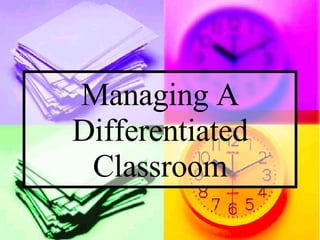Part 1 Management
- 1. Managing A Differentiated Classroom
- 2. How do I make it all work? Fact: Many teachers fear the management of a differentiated classroom. Fact: Teachers fear not covering required content. Fact: Teachers are skilled at attending to multiple signals. Fact: Teachers juggle everyday!
- 3. The Learner at the Center Keep in mind learning styles, multiple intelligences and preferences. Observe students: as they work and interact- Keep student reflections, surveys,etc. NOW CONSCIOUSLY include a variety of learning and assessment experiences that will engage a greater number of students
- 4. Avoiding Ī«lowsĪ» and Ī«highsĪ» Group and regroup Ī« Mixing things upĪ» reduces the focus of who is in which group. Ī« Fun stuffĪ» Do away with low-level paper-and-pencil seatwork for review or work on basic tasks. Ī« MoreĪ» work Better to have more challenging work than just Ī«moreĪ» work for advance learners.
- 5. Managing Flexible Groups Meet individually with small groups Allocate time based on need for direct instruction and teacher feedback. Plan activities for groups who need only minimal direction. Create tasks students can manage independently after you give directions. Establish behavior guidelines i.e. noise level, movement, etc.. Communicate when you are off-limits during small group work time
- 6. Create and deliver instructions carefully. Use task cards Use tape recorded directions Use overhead or flip chart Give directions to a few responsible students Model small group tasks
- 7. Establish routines for getting help. When you are off-limits during small group work timeĪŁ Become good listeners Repeat what you said Someone to summarize Someone to ask Classroom experts Move to anchor activity
- 8. Develop plan for turning in work. Stacking letter files to hold work Hanging files by subject or student. Crates or counter space for larger projects.
- 9. Minimize stray movement and promote on-task behavior. Ī░ExpertĪ▒ of the day resource person. Designate a helper for each group. Develop Ī░plus/minusĪ▒ system for identifying students on-task behaviour. Subtle signals
- 10. Plan for the Ī░quick finishers.Ī▒ Expect their best. Quick finishers must be held to high quality. Provide rubrics or checklists to convey your expectations about quality and samples or examples to guide them. Learn to identify if the quick finisher needs more of a challenge. Enrichment, contests, anchor ideas, etc.
- 11. Try and try again. Vary the resources Vary the pace of students Vary instructional technique Vary grouping Vary subjects Vary classroom environment










